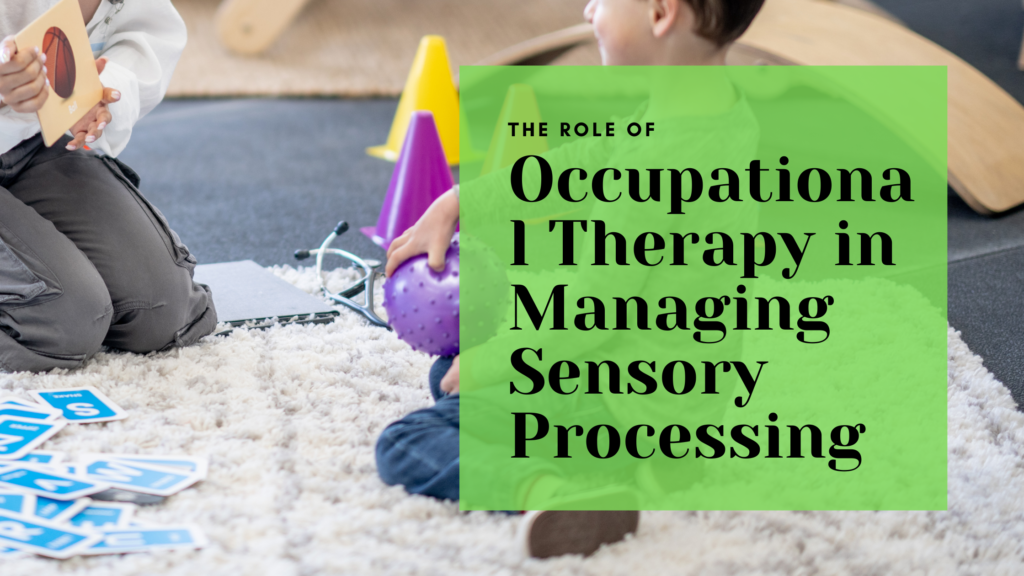I. Introduction
Sensory integration therapy (SIT) is a therapeutic approach designed to help autistic individuals manage their sensory processing challenges. Many autistic people experience difficulties in processing and responding to sensory input, such as sound, touch, or light. This can lead to sensory overload or under-responsiveness, affecting their ability to focus, learn, and interact with others.
SIT has become a growing method in autism treatment as it helps improve how the brain processes sensory information, making daily life more manageable for those with autism. In this article, we will explore the benefits, methods, and overall role of sensory integration therapy in supporting autistic individuals.
II. What is Sensory Integration Therapy?
Sensory integration therapy is a treatment designed to improve how the brain processes sensory information. It focuses on helping the brain organize and respond appropriately to sensory stimuli, such as sounds, sights, textures, and movements. Dr. A. Jean Ayres, an occupational therapist, developed SIT in the 1970s to address sensory processing issues. Her theory was that improving the brain’s ability to process sensory input could lead to better behavior, motor skills, and emotional regulation.
SIT is highly individualized, meaning it’s tailored to meet each child’s specific sensory needs. For children with autism, SIT can help them better respond to sensory stimuli by gradually improving their tolerance to challenging inputs like loud noises, bright lights, or certain textures.
III. Why Sensory Processing Issues Are Common in Autism
Many autistic individuals experience sensory processing disorder (SPD), where the brain struggles to interpret and respond to sensory information correctly. SPD is closely linked to autism, with many individuals showing either hypersensitivity (over-responsiveness) or hyposensitivity (under-responsiveness) to sensory stimuli.
For example, a child with hypersensitivity might find loud noises unbearable, while a child with hyposensitivity might seek out intense sensory experiences, like spinning or jumping, because they don’t feel sensory input as strongly. These sensory processing issues can lead to difficulties in behavior, learning, and social interactions. Autistic individuals might experience meltdowns, anxiety, or withdrawal in overwhelming environments, which makes everyday activities challenging.
IV. Goals and Benefits of Sensory Integration Therapy for Autism
Improving Sensory Processing
The primary goal of SIT is to help autistic individuals better process sensory information. By targeting the brain’s response to sensory stimuli, SIT helps reduce sensory overload or under-stimulation, making it easier for children to function in their daily environments.
Enhancing Motor Skills
SIT also focuses on improving motor skills, such as balance, coordination, and fine motor abilities. Through activities like swinging, balancing, and using tactile objects, children develop better body awareness and control, which are important for daily tasks like writing or playing.
Supporting Emotional Regulation
Many autistic children struggle with emotional regulation, especially when they are overwhelmed by sensory input. SIT helps them learn to manage their anxiety, frustration, or meltdowns by improving how they respond to sensory stimuli.
Boosting Attention and Focus
SIT can also help improve focus and attention in tasks. When sensory input is better regulated, autistic children can concentrate more effectively in school or during therapy sessions.
Promoting Independence
By teaching children to self-regulate their sensory needs, SIT promotes greater independence. This means children are better able to manage their sensory environments without relying on constant support from caregivers.
V. How Sensory Integration Therapy Works
Initial Assessment
Before starting SIT, an occupational therapist (OT) conducts a sensory profile assessment. This assessment identifies the child’s sensory processing difficulties, including which stimuli cause discomfort or which ones are sought out. The assessment is the foundation for creating a personalized therapy plan.
Creating a Sensory Diet
Based on the assessment, the therapist creates a sensory diet, which is a customized set of activities designed to regulate sensory input. This might include activities that stimulate or calm the senses, depending on the child’s needs. For example, deep-pressure activities might be included for children who need calming input.
Hands-On Therapy Techniques
During SIT sessions, the therapist uses hands-on techniques to engage the child’s senses. Common techniques include:
- Swinging or balancing to improve vestibular (balance) function.
- Tactile activities like playing with sand or textured objects to engage the sense of touch.
- Deep-pressure activities like squeezing or using weighted blankets to provide calming input.
Gradual Exposure to Sensory Input
A key component of SIT is gradual exposure to challenging sensory stimuli. By slowly increasing the child’s exposure to overwhelming stimuli in a controlled environment, SIT helps desensitize the child and increase their tolerance over time.
VI. Types of Sensory Activities Used in Sensory Integration Therapy
Tactile Activities
Tactile activities engage the sense of touch, helping children become more comfortable with different textures. Examples include playing with sand, using sensory bins filled with beans or rice, or handling textured objects.
Proprioceptive Activities
Proprioception refers to body awareness, and activities that engage this sense can help improve coordination and control. Jumping, pushing, pulling, and using weighted blankets are common proprioceptive activities that help the child become more aware of their body in space.
Vestibular Activities
The vestibular system controls balance and movement. Activities like swinging, rocking in a chair, or using a balance board help regulate this system. These activities can be calming for children who struggle with balance or body movement.
Auditory and Visual Activities
For children with sensitivity to sounds or light, SIT uses auditory and visual activities to help them become more comfortable with these stimuli. This might include listening to white noise, adjusting the brightness of the room, or using visual tracking exercises.
VII. The Role of Occupational Therapists in Sensory Integration Therapy
Customized Therapy Plans
Occupational therapists work closely with families to create a personalized SIT plan based on the child’s specific sensory needs. These plans are designed to target the sensory challenges that interfere with daily life, such as hypersensitivity to sounds or under-responsiveness to touch.
Ongoing Monitoring and Adjustments
Therapists regularly monitor the child’s progress and adjust the sensory activities as needed. For example, if the child becomes more tolerant of certain stimuli, the therapist may introduce more challenging activities to further improve sensory processing.
Collaboration with Parents and Teachers
It’s crucial for parents and teachers to be involved in the therapy process. Therapists often teach parents and educators how to support the child’s sensory needs outside of therapy sessions. This collaboration helps ensure that the child is getting consistent sensory support at home and in school.
VIII. The Effectiveness of Sensory Integration Therapy
Research and Studies
Several studies support the effectiveness of SIT in improving sensory processing in autistic individuals. A study by Schaaf et al. (2014) found that sensory integration therapy led to improvements in behavior, attention, and motor skills in autistic children . However, some research suggests that while SIT is beneficial for many children, its effectiveness can vary based on individual differences.
Success Stories
There are many success stories of children who have benefited from sensory integration therapy. For example, a child who struggled with overwhelming sounds may, after several months of SIT, become more comfortable in noisy environments like a classroom or playground. These improvements not only help with sensory processing but also lead to better emotional regulation and social interactions.
Limitations of SIT
While SIT can be highly effective for some, it is not a one-size-fits-all solution. The therapy requires a long-term commitment and consistency, and the results may vary depending on the child’s specific sensory challenges and how early the therapy is started.
IX. Integrating Sensory Integration Therapy Into Daily Life
At Home
Parents can incorporate SIT activities into their child’s daily routine at home. Simple sensory activities, such as using a weighted blanket before bed or playing with textured objects during playtime, can help maintain the progress made during therapy sessions.
At School
Teachers can support sensory integration by providing sensory breaks during the school day. For example, allowing the child to use a fidget toy during class or creating a quiet corner where they can retreat if they feel overwhelmed.
In Public
When in public spaces, parents can use sensory strategies from SIT to prevent sensory overload. Noise-cancelling headphones, fidget toys, or finding quiet areas can help the child manage their sensory environment more effectively.
X. Conclusion
Sensory integration therapy plays a critical role in helping autistic individuals improve their sensory processing, emotional regulation, and motor skills. By working closely with occupational therapists and incorporating sensory activities into daily life, parents and educators can provide essential support to help children thrive. While SIT requires time and dedication, its benefits for improving sensory balance and promoting independence are significant.
References:
- Schaaf, R. C., Benevides, T., Mailloux, Z., Faller, P., Hunt, J., Hooydonk, E., … & Kelly, D. (2014). An intervention for sensory difficulties in children with autism: A randomized trial. Journal of Autism and Developmental Disorders, 44(7), 1493-1506. https://doi.org/10.1007/s10803-013-1983-8.
- Schaaf, R. C., & Davies, P. L. (2010). Evolution of the sensory integration frame of reference. American Journal of Occupational Therapy, 64(3), 363-367. https://doi.org/10.5014/ajot.2010.09075.
- Baranek, G. T. (2002). Efficacy of sensory and motor interventions for children with autism. Journal of Autism and Developmental Disorders, 32(5), 397-422. https://doi.org/10.1023/A:1020541906063.
- National Institute of Mental Health. (2018). Autism spectrum disorder. Retrieved from https://www.nimh.nih.gov/health/topics/autism-spectrum-disorders-asd/index.shtml.
Here’s a table with 10 key points based on the article:
| # | Key Point | Description |
|---|---|---|
| 1 | Understand Sensory Processing in Autism | Sensory integration therapy helps autistic individuals process sensory information more effectively, reducing sensory overload. |
| 2 | Know the Benefits of Sensory Integration Therapy | SIT can improve sensory processing, motor skills, Emotional regulation, and increase attention and focus in autistic individuals. |
| 3 | Work with Occupational Therapists | Occupational therapists create personalized therapy plans that target a child’s specific sensory needs through structured activities. |
| 4 | Identify Sensory Challenges Early | Early identification of sensory issues helps target the right interventions, which can improve behavior and learning outcomes. |
| 5 | Use Hands-On Sensory Activities | Sensory integration therapy includes activities like swinging, tactile play, and balancing to engage different sensory systems. |
| 6 | Encourage Gradual Exposure to Sensory Stimuli | Sensory integration therapy uses controlled exposure to challenging stimuli to help children become more tolerant over time. |
| 7 | Incorporate Sensory Integration Techniques at Home | Parents can use SIT strategies at home by incorporating sensory tools and activities into daily routines for consistency. |
| 8 | Collaborate with Teachers for Classroom Support | Sensory integration therapy can be supported in the classroom through sensory breaks, flexible seating, and calming tools. |
| 9 | Monitor Progress and Adjust as Needed | Regularly assess how the child is responding to sensory integration therapy and adjust techniques as sensory needs evolve. |
| 10 | Be Patient and Consistent | Progress in sensory integration therapy may take time, so consistency and patience are key to achieving long-term improvements. |
This table provides a clear summary of the key points to keep in mind when understanding and implementing sensory integration therapy for autism.


